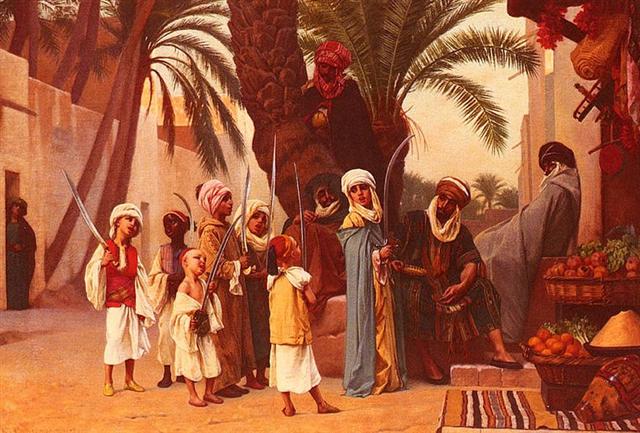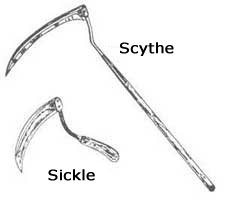7. More from Allen: "Brown writes as to the origin of the title Aries, without any supposition of resemblance of the group to the animal: The stars were regarded by a pastoral population as flocks; each asterism had its special leader, and the star, and subsequently the constellations, that led the heavens through the year was the Ram. Elsewhere he tells us that when Aries became chief of the zodiac signs it took the Akkadian titles Ku, I-ku, and I-ku-u, from its lucida Hamal, all equivalents of the Assyrian Rubū, Prince, and very appropriate to the leading stellar group of that date, although not one of the first formations. He also finds, from an inscription of the Tablet of the Thirty Stars, that the Euphratean astronomers had a constellation Gam, the Scimitar, stretching from Okda [another name for Alrisha, the knot] of the Fishes to Hamal of Aries, the curved blade being formed by the latter's three brightest components. This was the weapon protecting the kingdom against the Seven Evil Spirits, or Tempest Powers." The Field, alias 1-iku or the Pegasus Square, therefore seems to mean the 'first prince'. At Camp 6 I quoted from Hamlet's Mill: ... Utnapishtim is spry enough to tell [Gilgamesh] in great detail the story of the Deluge. He tells how Enki-Ea has warned him of Enlil's decision to wipe out mankind, and instructed him to build the Ark, without telling others of the impending danger. 'Thus shalt thou say to them: (I will ... go) down to the apsu and dwell with Ea, my (lor)d.' He describes with great care the building and caulking of the ship, six decks, one iku (acre) the floor space, as much for each side, so that it was a perfect cube [a sign of Saturn], exactly as Ea had ordered him to do. This measure '1-iku' is the name of the Pegasus-square, and the name of the temple of Marduk [the spring sun god] in Babylon, as is known from the New Year's Ritual at Babylon, where it is said: 'Iku-star, Esagil, image of heaven and earth.'
... Esagila is '1-iku - the Pegaus-square between the two Fishes that ruled the hibernal solstice during the Age of Gemini ... The 'inundation' of 'earth' in the 4th and last quarter of the year necessitates some kind of vessel for the Sun King to survive. Wikipedia has some interesting remarks concerning the origin of the name Aries: "In the description of the Babylonian zodiac given in the clay tablets known as the MUL.APIN, the constellation now known as Aries was the final station along the ecliptic. It was known as MULLÚ.ḪUN.GÁ, 'The Agrarian Worker'. The MUL.APIN is held to have been compiled in the 12th or 11th century BCE, but it reflects a tradition which takes the Pleiades as marking vernal equinox, which was the case with some precision at the beginning of the Middle Bronze Age (early 3rd millennium BCE). In later Babylonian tradition, the name of the constellation changes to MULUDU.NITÁ 'ram'. The motive for the name change is unknown. John H. Rogers suggests that the 'Agrarian Worker' became the 'Ram' via association with the legendary figure of Dumuzi the Shepherd. Gavin White suggests that the sumerogram LÚ 'man' may have come to be understood as Akkadian lu 'sheep'. Aries only rose to its prominent position as the leading sign of the zodiac in the Neo-Babylonian (7th century BCE) revision of the Babylonian zodiac, as Hamal (α Ari) came to be located close to the point of vernal equinox. In Hellenistic astrology, the constellation of Aries is associated with the golden ram of Greek mythology that rescued Phrixos on orders from Mercury, taking him to the land of Colchis. Phrixos sacrificed the ram to the gods and hung its skin in a temple, where it was known as the Golden Fleece. The Golden Fleece was then stolen by Jason and the Argonauts. The First Point of Aries, the location of the vernal equinox, is named for the constellation. This is because the Sun crossed the celestial equator from south to north in Aries more than two millennia ago. Because of the precession of the equinoxes, the First Point of Aries has since moved into Pisces and will move into Aquarius by around 2600 C.E. The Sun now appears in Aries from late April through mid May." I would not be surprised if the god Ku got his name from the Akkadian prince title Ku, because the Hawaiian god rescued his people from starvation by sacrificing himself (cfr at The Queen of Hearts): ... According to an etiological Hawaiian myth, the breadfruit originated from the sacrifice of the war god Ku. After deciding to live secretly among mortals as a farmer, Ku married and had children. He and his family lived happily until a famine seized their island. When he could no longer bear to watch his children suffer, Ku told his wife that he could deliver them from starvation, but to do so he would have to leave them. Reluctantly, she agreed, and at her word, Ku descended into the ground right where he had stood until only the top of his head was visible. His family waited around the spot he had last been, day and night watering it with their tears until suddenly a small green shoot appeared where Ku had stood. Quickly, the shoot grew into a tall and leafy tree that was laden with heavy breadfruits that Ku's family and neighbours gratefully ate, joyfully saved from starvation ...
Ku was a war god and so was Mars. In an agrarian world the new generation must be based on the old - the 'head' of spring growth is based on the dry old specimens which are buried in the ground. "Tammuz was a month in the Babylonian calendar, named for one of the main Babylonian gods, Tammuz (Sumerian: Dumuzid, 'son of life'). Many different calendar systems have since adopted Tammuz to refer to a month in the summer season. In the Hebrew calendar, Tammuz is the tenth month of the civil year and the fourth month of the ecclesiastical year on the Hebrew calendar. It is a summer month of 29 days. Tammuz is also the name for the month of July in the Gregorian calendar ..." (Wikipedia) The origin of the idea of Spurinna, that Julius Ceasar was doomed to die before the summer year arrived, presumably at the end of the old year, may have been based on his birth month July (Tammuz). The 'son of life' had to die, it seems. We can compare with how the life of the son Moku-ola ('the living islet') was based on the death of his father: ... The little spring was concealed by a succulent growth of strange plants, bearing gigantic leaves and pendant clusters of long yellow fruit, which she named bananas. The intervening space was filled with a luxuriant growth of slender stems and twining vines, of which she called the former sugar-cane and the latter yams; while all around the house were growing little shrubs and esculent roots, to each one of which she gave an appropriate name. Then summoning her little boy, she bade him gather the breadfruit and bananas, and, reserving the largest and best for the gods, roasted the remainder in the hot coals, telling him that in the future this should be his food. With the first mouthful, health returned to the body of the child, and from that time he grew in strength and stature until he attained to the fulness of perfect manhood. He became a mighty warrior in those days ... When the old ruler was sacrificed the instrument of death evidently had to be made of iron (the metal of Mars):
Arabs with scimitars from Boulanger's painting A Tale of 1001 Nights. Ceasar was stabbed and so was Captain Cook - 'finished' with an iron knife in his back by a representatitive of the native people.
On Easter Island the 'agrarian worker' must have been Kuukuu, also doomed to an 'untimely' death. But iron could not be obtained and therefore the 'flipper' of a 'turtle' was used.
The Bull of Heaven has a strange horn. Could it be interpreted as a 'flipper'? They look at each other, the Hired Man and the Bull of Heaven. The 'rainbow' horn of the Hired Man (announcing the arrival of Sun after rain) could be reflected as a sign for how the watery winter is leavingIn Gb7-30 such a sign of leaving, 'leg' (haati), is exhibited at right:
From the single not inverted haati in Gb7-30 to the pair of inverted haati in Gb1-16--17, from the 'flipper leg' leaving to the arrival of a pair of them, there are around 280 glyphs (days):
As to the rainbow sign we ought to recognize the ua glyph type (where it is doubled to indicate the arrival of rain rather than rain leaving):
The single sign (half ua) is located where we can identify it as the rainbow sign, when Sun is returning:
Though in Gb3-30 (glyph number 91 from the beginning of side b and in the line without any henua signs) the front 'leg' is drawn down to prevent light from entering (negating the rainbow sign and changing the meaning to its opposite). A pau 'foot' sign signifies the end of the season of Sun, cfr at Hanga Takaure. Equipped with these ideas it is possible to state that the rainbow sign in the Babylonian zodiac can be perceived as a sign of rain (ua) which has been cut in two as if by a scimitar. This explains why there is a pair of rainbow signs. |
|||||||||||||||||||||||||||||||||||||||||||||||||||||||||||||||||||||||||||||||||||||||||||
















